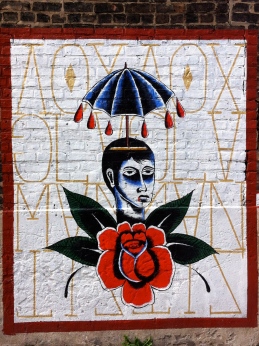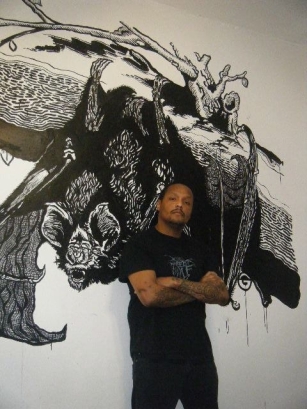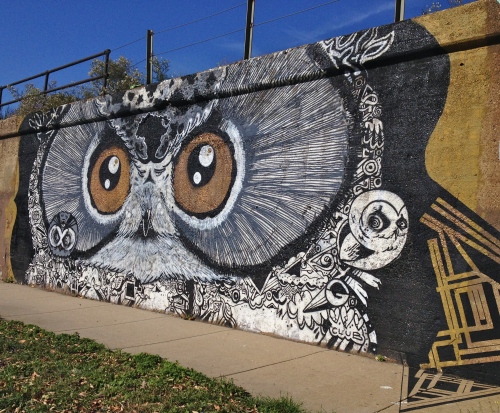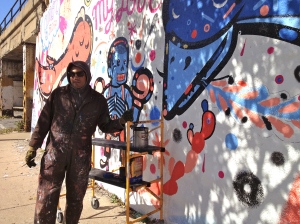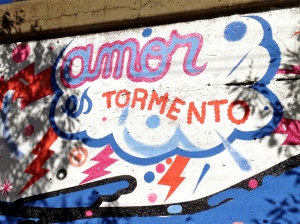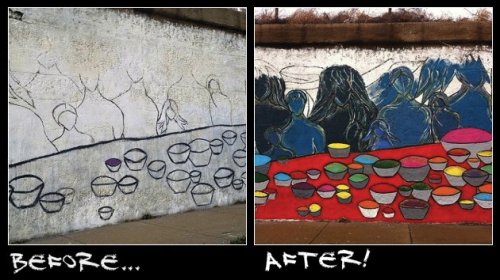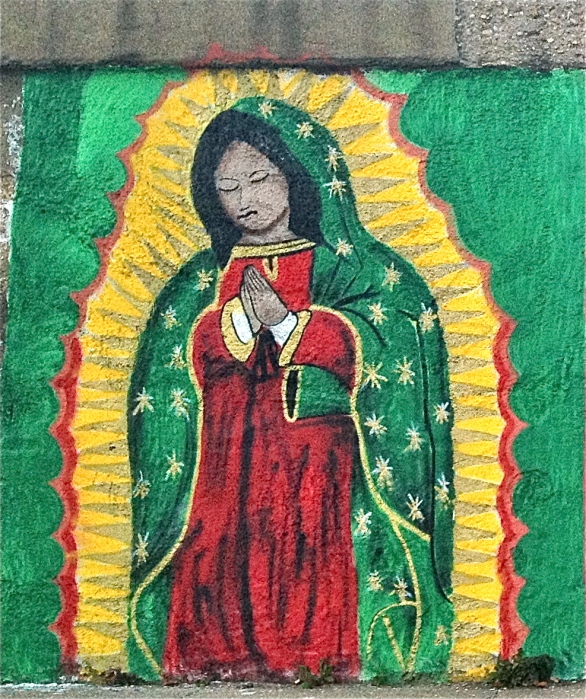-

“I’m not really hiding anything,” says Nice One, about wearing masks at his shows. “I just think it’s fun.” (Photo courtesy of Nice One)
All the way from The Mile-High City, the Denver-bred artist known as Nice One moved to Chicago when he was just a 13-year-old skater kid. He discovered his innate passion for the arts at an early age, but Nice One says it was skateboarding that acted as the bridge to him displaying his art in public places. It was when he began looking at how he could use his environment to his advantage.
A 2009 fine arts alumni from Columbia College Chicago and now, a well-known, respected artist, the 26-year-old spoke to On The Wall about his craft and his involvement with the “Art in Public Places” project in Chicago’s Pilsen neighborhood. Here’s what he had to say:
OTW: So when did you fall in love with Art?
NICE ONE: I guess it was just kind of a lifelong thing. I always liked drawing as a kid and I kind of never grew up. I’m just a big kid in a way. One of my first experiences with drawing that I can remember was when I was in kindergarten. We were told to paint something with a sentence and I wasn’t a very good speller. I learned how to spell one word: Snow. I wrote, “I like snow” for 2 months straight and with that, I drew all sorts of snowmen, all sorts of crazy families, technicolored snowmen, it was awesome. I remember having a lot of fun and feeling so inspired by just drawing snowmen.
OTW: What would you consider yourself: a Street Artist, a Graffiti Artist, a Muralist? Is there even a difference?
NICE ONE: I’m multidisciplinary. I’m not just a street artist because I’ve done all sorts of different things. I’ve sewn and done needlepoint. I’ve screen-printed. I get a lot of enjoyment from doing various things. The same way contemporary art can’t really be defined, the same applies to graffiti and street art. I personally don’t feel like I can define myself as one or the other.
OTW: If you could describe your style of work in one word, what would it be?
NICE ONE: A doodler. I’m kind of like a world builder. I have my own fantasy that I like to carry out in my art.
OTW: How did you become involved with the mural project in Pilsen?
NICE ONE: Through Lauren Pacheco and Peter Kepha from Chicago Urban Arts Society, they were my major connect to that project. I’ve worked with them twice before. I did a Pop-Up art show on State & Adams and we worked together on another mural on 18th street and Carpenter. When creating a mural you’re in a position where you’re engaging with people and Lauren knew I liked working in public spaces.

Nice One’s “Let It Rain In The City” mural (Photo by Samantha Peña)
OTW: Your piece really stood out to me, the vibrant colors and the phrase itself. What’s the story behind it? Why “Let it rain” and not “Let the sun shine in the city?”
NICE ONE: [Laughs] I was just pulling from dialogue from people my own age. I’m always listening to rap and hip hop, you know that whole phrase, “Let it rain,” it can be understood in different ways so I like to play off of that.
OTW: How long did it take to finish it?
NICE ONE: It took me four days. That wall is really tough and I’m still very fresh to murals.
OTW: Wow, that’s impressive. Was that your first time doing a mural that big?
NICE ONE: That’s the biggest that I’ve done to date. I think that wall’s about 80 feet.
OTW: So do you plan on doing any more murals on 16th Street?
NICE ONE: I hope so. I actually hope to go back to that wall and keep working on it at some point. There’s some other things I want to do with it now, but there’s some other plans brewing with people I know from that stretch of wall between Laflin Street and Blue Island, so I’m sure I’ll be around those areas again in the spring.
OTW: What is it that you want to add to your piece?
NICE ONE: Just more characters. That’s the great thing about having a wall. It’s yours and you can always go back to it. I mean it’s done now, but it can be done even more.
OTW: Where else can one find your work in Chicago?
NICE ONE: You can find some at a couple different galleries in the city and other walls. You can also find some of my stuff through the HOTBOX Mobile Gallery, that’s another project I’m working on.
OTW: Cool, what’s the HOTBOX gallery all about?

The HOTBOX Mobile Art Gallery (Photo courtesy of Nice One)
NICE ONE: It’s an art mobile gallery ran between me and my girlfriend, Tara. She’s a designer and artist so we collaborate a lot. HOTBOX is a 22 foot truck that we made into a gallery for unconventional artists. It’s for people that work in the public space and for people that want to engage with different people in different ways with a public space. We’re a project-based gallery so we don’t have shows regularly and we don’t have a specific location, but you can find us in Pilsen, Bridgeport and Wicker Park. It’s an old truck so we try not to venture too far, but yea, we do projects pretty consistently in the summer.
OTW: Have you done any work outside of the U.S.?
NICE ONE: I went to Brazil in 2008. It was very much a community oriented project. We were in the villas painting walls. Bringing color to areas like that can be very uplifting and motivational.
OTW: Where do you draw your inspiration from?
NICE ONE: People in my life, my friends, the community around me, my own imagination. My inspiration is all over the place.
OTW: Any upcoming shows you’d like the world to know about?
NICE ONE: I can’t give too much away, but me and a really dope street artist that goes by Lucx have a dual show coming up at Galerie F in January. That’s going to be rad.
OTW: Nice One, thanks so much. Before we wrap this up, is there anything else you’d like to share?
NICE ONE: I’m just a big kid and I like to share my world with everyone else, whether they like it or not [Laughs].
By Samantha Peña







